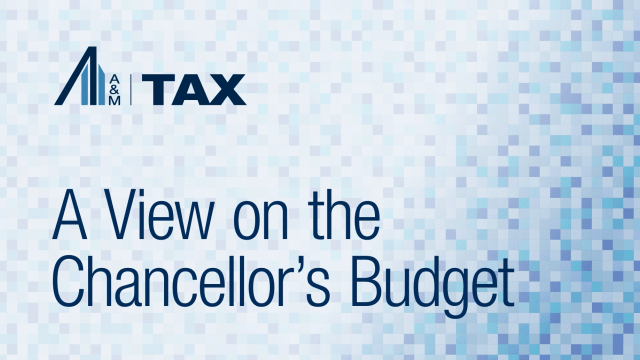The 3-Step Tax Answer to Dodd-Frank's Recently Required Resolution Plans
Wall Street reform and related financial regulation designed to prevent the U.S. taxpayer from having to “bail out” another financial crisis is now a reality. The Federal Deposit Insurance Corporation (FDIC) recently issued proposed regulations implementing its new Orderly Liquidation Authority (OLA), under which the FDIC can seize and liquidate large systemically important financial institutions when their collapse threatens the U.S. economy. The OLA can even replace the bankruptcy code for these liquidations. The proposed regulations (March 2011) have a lot of financial companies scrambling to understand the regulations, strategize and respond. Meanwhile, another group of companies is anxiously waiting to be subject to the rules. In this article, I will generally describe the FDIC’s recently issued requirement and the associated tax issues.
In doing so, I’ll discuss some concepts you may have read about recently and begin to define the associated tax issues that might arise. Some of the new concepts (like systemic risk — the risk that one failure will cause another and another and another — and susbsidiarization — the concept that a certain commercial activity can be ring-fenced in a legal entity in a given jurisdiction for regulatory oversight purposes) are still being debated. But what isn’t being debated is that the FDIC is requiring systemically important financial institutions (SIFIs — or financial institutions that are deemed to have systemic risk) to report on certain matters, as mandated by the Dodd–Frank Wall Street Reform and Consumer Protection Act.
Who Is Affected?
Soon, a group of SIFIs (124 of them for now, and not all are “banks”) will be required to deliver a resolution plan to the FDIC explaining how they could be unwound while avoiding systemic risk and maintaining value. These 124 SIFIs are bank holding companies with assets equal to or in excess of $50 billion and non-bank financial companies designated by the Financial Services Oversight Committee (FSOC) to be supervised by the Federal Reserve. The FSOC is the new federal agency that includes regulators from many industries and that was established to share information to better understand and regulate global financial issues.
Step 1: Determine if you are employed at one of the chosen 124 SIFIs.
Within each SIFI, a team (likely reporting to the chief financial officer or chief risk officer and even the board of directors) will be responsible for preparing the plan. Corporate tax departments need to be a part of that team (for this article, I’ll refer to the Dodd-Frank team of internal and external resources tasked with developing the plan as the “DFT”).
What the FDIC will do with these resolution plans is uncertain. What is certain is that each DFT needs to prepare a credible resolution plan. And, let’s be honest, in some form or fashion, the SIFIs required to report will find that “too big to fail” or “too connected to fail” exists. So, the plans will need to have strategies to manage capital, liquidity and leverage for the pieces that are “too big to fail” or “too connected to fail.”
Credible plans will demonstrate thoughtful and thorough analysis, including their anticipated tax implications. Many of the 124 SIFIs have tax assets that represent a significant portion of their total equity. Under certain scenarios, the assets might not be realized, or even worse, the tax assets could become liabilities. Understanding the plans will allow corporate tax departments to analyze the issues and develop the proper after-tax values that are required under a credible plan.
What Is the Time Frame?
Well, the first 124 SIFIs will need to submit their plans 90 days after the regulations are finally published in the Federal Register (and the plans must be updated annually or earlier if a triggering event materializes). The regulations were issued on March 29, 2011 and are still open for comment (and so, not final yet). Under the most aggressive timing, the first plans could be due by year-end 2011.
The Resolution Plan
The plan is essentially a Chapter 11 liquidation plan that seeks to minimize systemic risk and maintains value, in light of all kinds of distress. After that, it gets kind of fuzzy…
Step 2: Develop a Chapter 11 plan and run scenarios developed by the team in charge of preparing it.
The DFT will need to take into account many new and unusual risks. Risks might include defaults on sovereign debt, cease and desist orders, evaporation of the U.S. mortgage market, the collapse of the credit default swap market, or even a nuclear disaster to the extent it creates risk to the SIFI’s financial condition. In an effort to address systemic risk (and preserve value), the plan will consider many strategies. Each scenario and strategy will have its own peculiar tax issue. In the aggregate, the issues could cause unusual and materially negative outcomes to capital and liquidity.
Step 3: Report findings to the CFO and board of directors prior to submitting to the FDIC. If not ready, go back to Step 2.
The Tax Analysis for a Resolution Plan
You will need to have (or it would make it easier if you have) a tax model that can analyze historical tax positions, the assumptions in the plan, the risks identified in the plan that are assumed to materialize and the contingencies that can affect historical positions and available attributes to pay taxes or offset income items caused by the plan. At a minimum, the tax model needs to contain the following relevant items:
- Historical and projected taxable income;
- Tax attributes available for utilization by period — net operating losses for both regular and alternative minimum tax (AMT) purposes, AMT credits, foreign tax credits and related foreign-source income, general business and other credits, tax basis of assets and stock, deferred intercompany transactions, excess loss accounts, excess inclusion income, capital gains and losses and other relevant items;
- Contingencies that affect the reported amounts of taxable income and generation or utilization of tax attributes (even better if you can toggle different outcomes of the contingencies in the modeling period); and
- Identification of tax triggers that result in current cash tax or utilization of tax attributes.
The idea behind the tax model is to have a centralized analytical tax tool that can model various scenarios around changes to capital, liquidity and leverage in your SIFI. It needs to manage the tax triggers that (a) cause taxable income to be recognized, (b) result in taxable income floors or (c) create limitations on tax attribute utilization. These triggers are not the usual triggers that exist in healthy (non-resolution planning) times. Examples of triggers include:
- Lack of foreign-source income in the future limiting realization of foreign tax credits;
- Debt modification (including cancellation);
- Excess inclusion income;
- Alternative minimum tax;
- Foreign loss carrybacks potentially eliminating foreign taxes and previously claimed foreign tax credits;
- Deconsolidation;
- Reversal of overall domestic or foreign income and loss positions; and
- Changes of control.
The tax issues associated with the plan cannot be summarized easily. If ignored, they will lead to many tax guesses without the proper data, analyses or global tool to manage the process. Credibility will be lacking.
Tax Attribute Utilization
The value of all available tax attributes can disappear quickly and cause further erosion to capital and liquidity if not properly managed. Given the relatively high value of deferred tax assets of many of the 124 SIFIs producing these plans, the tax considerations cannot be ignored or be an afterthought. Here are some issues to keep in mind from an Internal Revenue Code Section 382 perspective:
- Subsidiarization — The process of establishing subsidiarization could trigger a change in control, severely limiting or eliminating the value of your tax attributes. It can also trap certain income and loss in an entity or jurisdiction.
- Equity offerings — Equity offerings to manage capital and liquidity might trigger a change of control.
- Governance issues — Governance issues can cause a lack of affiliation under Section 1504(a)(2).
- Debt issuances — You might need to consider the applicable high-yield discount obligation (AHYDO) rules or attempt to maintain flexibility to achieve a Section 382(l)(5) creditor-buy-in plan.
- Exiting a line of business — This can also limit the generation and utilization of tax attributes.
- FDIC seizure — Although FDIC seizure does not necessarily end a tax consolidation, the FDIC does obtain unusual powers over the federal consolidated return, including filing its own refund claims and negotiating unique settlements of intercompany taxes both historical and in the future. If your company has FDIC-regulated entities, you need to address this potential event in your plan.
- Foreign seizure — Similar to a seizure by the FDIC, likely, foreign regulators could seize entities under their jurisdiction to prevent failures. Such seizures need to be managed for potential changes to foreign tax credit utilization and calculations of foreign-source income, foreign earnings and profits, Subpart F income and other relevant items.
Other non-Section 382 issues can also impact the realizability of tax attributes. Since realizing the value of tax attributes requires generating certain types of income of the appropriate character in the appropriate periods, certain plan issues might diminish the ability to realize a tax attribute. For example, if your SIFI is unable to generate foreign-source income, it might not be able to utilize foreign tax credits. Similarly, if losses in foreign jurisdictions are utilized in an unanticipated and uncontrolled manner (because of foreign receivership and bankruptcy issues), the amount of foreign tax credits available in the U.S. might be affected. Cancellation of debt income might be realized in one entity, while the consolidated return regulations require attribute reduction in other subsidiaries where attributes have been “housed” (Treas. Reg. Sec. 1.1502-28). The issue is not whether or not to record a valuation allowance (under ASC 740), but rather what further capital will be eroded by taxes and what additional liquidity requirements might be driven by unforeseen taxes.
Other Unique Issues to Consider
Other unique issues that arise while preparing a plan include the need to understand and treat the IRS as a standalone creditor and not just as a member of the general unsecured creditors, the need to understand historical tax-sharing agreements (or the lack thereof) and how taxes have been shared, and the need to understand federal and state conformity and nonconformity.
Alvarez & Marsal Taxand Says:
- If your company is a SIFI, become familiar with the Dodd-Frank legislation and relevant regulations.
- Begin to think of tax issues relating to capital, liquidity and leverage triggers that are more closely managed by senior financial management.
- Connect with the Dodd-Frank team in your organization. Tax has always been a value driver and, to some extent, a significant portion of a SIFI’s capital. That value has to be modeled and managed in new and unimaginable ways in the Dodd-Frank world.
- Don’t wait assuming that these rules don’t apply to you. Be proactive and understand the resolution plans and what impact they might have on tax capital and liquidity.
- Model your overall tax position and understand how the contingencies might unwind, how attributes might be realized (or not) and how the former items mix with the resolution plans and maximize value (capital and liquidity).
Author
Layne Albert
Managing Director, New York
212-763-9655
| Profile
For More Information on this Topic, Contact:
James Carreon
Managing Director, San Francisco
415-490-2121
| Profile
Juan Carlos Ferrucho
Managing Director, Miami
305-704-6670
| Profile
Ernesto Perez
Managing Director, New York
305-704-6720
| Profile
Donald Roveto
Managing Director, New York
212-763-9632
| Profile
Mark Young
Managing Director, Houston
713-221-3932
| Profile
Other Related Issues:
| 04/14/2011 | |
| 03/30/2011 | |
| 01/26/2011 |
Feedback:
We would like to hear from you.
.
Disclaimer
As provided in Treasury Department Circular 230, this publication is not intended or written by Alvarez & Marsal Taxand, LLC, (or any Taxand member firm) to be used, and cannot be used, by a client or any other person or entity for the purpose of avoiding tax penalties that may be imposed on any taxpayer.
The information contained herein is of a general nature and based on authorities that are subject to change. Readers are reminded that they should not consider this publication to be a recommendation to undertake any tax position, nor consider the information contained herein to be complete. Before any item or treatment is reported or excluded from reporting on tax returns, financial statements or any other document, for any reason, readers should thoroughly evaluate their specific facts and circumstances, and obtain the advice and assistance of qualified tax advisors. The information reported in this publication may not continue to apply to a reader's situation as a result of changing laws and associated authoritative literature, and readers are reminded to consult with their tax or other professional advisors before determining if any information contained herein remains applicable to their facts and circumstances.
About Alvarez & Marsal Taxand
Alvarez & Marsal Taxand, an affiliate of Alvarez & Marsal (A&M), a leading global professional services firm, is an independent tax group made up of experienced tax professionals dedicated to providing customized tax advice to clients and investors across a broad range of industries. Its professionals extend A&M's commitment to offering clients a choice in advisors who are free from audit-based conflicts of interest, and bring an unyielding commitment to delivering responsive client service. A&M Taxand has offices in major metropolitan markets throughout the US., and serves the U.K. from its base in London.
Alvarez & Marsal Taxand is a founder of Taxand, the world's largest independent tax organization, which provides high quality, integrated tax advice worldwide. Taxand professionals, including almost 400 partners and more than 2,000 advisors in nearly 50 countries, grasp both the fine points of tax and the broader strategic implications, helping you mitigate risk, manage your tax burden and drive the performance of your business.
To learn more, visit www.alvarezandmarsal.com or www.taxand.com.
© Copyright 2011 Alvarez & Marsal Holdings, LLC. All Rights Reserved.
Alvarez & Marsal Taxand | 125 Park Avenue | Suite 2500 | New York | NY | 10017




